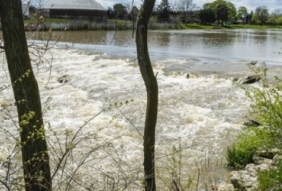
Posted on June 21, 2016
By Ray Kisonas, The Monroe News
Dredging crews are preparing to begin an $18 million River Raisin cleanup project that will mark the final phase of a nearly 30-year endeavor that began with the discovery of dead catfish in a basket.
Almost 25,000 cubic yards of PCB-contaminated sediment in an area that encompasses less than two acres will be dredged from the river’s bottom at the so-called hot spot near the old Ford plant and across from the Port of Monroe.
On Thursday night Scott Cieniaweski of the U.S. Environmental Protection Agency (EPA) told the Commission on the Environment and Water Quality board at Monroe City Hall that work is expected to begin next week and will conclude in November.
He said once the PCB-contaminated sediment is removed a cap consisting of stone, sand and other materials will cover the cleansed river bottom and withstand the repeated propulsions of cargo ships for the next 600 years.
“I feel it will be a big success,” Mr. Cieniaweski told the board members.
When the project is completed, then a once-polluted three-quarter-mile stretch of the river will be much cleaner. With much of the PCB-laden sediment removed, it will mean that within a few years, the consumption advisory for several species of fish, even bottom-feeders, is expected to be eased.
“We’re going to have a cleaner river,” Mr. Cieniaweski said.
The river bottom in the hot spot that is being scraped clean contains some of the highest levels of PCBs and other contaminants in the Sediment Remediation Project. It will be the fourth dredging project with a total cost that could reach $40 million, most of which was paid for by Ford, the Michigan Department of Environmental Quality and the EPA.
It all began in the 1980s when Dan Stefanski joined Roger Jones of the DNR on a catfish study. They set out cages in the river filled with catfish and when they retrieved the cage near the Ford plant every one of the fish was dead.
“They all went belly-up,” Mr. Stefanski said. “Something bad was in the water.”
From there he and Richard Micka in 1987 helped create the River Raisin Remedial Action Plan Public Advisory Council (RAPPAC). Ten years later the first phase of the project began and 20,000 cubic yards of sediment was removed. In 2010 another 60,000 cubic yards of sediment was collected and in 2012 78,000 cubic yards of contaminated sediment was gleaned from the river bottom. And next week the final phase of the project will commence. A permanent seawall already has been installed.
“It’s finally over,” Mr. Stefanski said.
“We’re very gratified to all the people involved,” Mr. Micka added.
Mr. Cieniaweski said once the project is completed, water and sediment testing will continue to make certain that the river remains as free of PCBs as possible.





